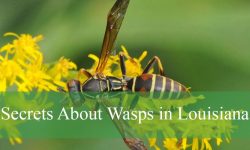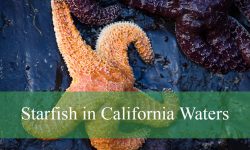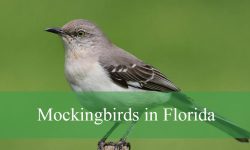Seagulls in Florida are a constant presence along shorelines, piers, and coastal towns. Their calls fill the air as they glide overhead or gather in noisy flocks near fishing boats and beachgoers. These adaptable birds thrive in both natural and urban environments, making them easy to observe across the state.
Florida provides ideal conditions for many types of seagulls, from permanent residents like the Laughing Seagull to winter visitors such as the Ring-billed and Herring Seagulls. During cooler months, the number and variety of seagulls increase significantly, offering birdwatchers a chance to spot both common and rare species.
This article introduces 7 common seagulls in Florida, with helpful pictures and identification tips. Each species is described in detail, including its appearance, behavior, and preferred habitats. Whether seen along a quiet stretch of beach or circling above a busy marina, these birds are a fascinating part of Florida’s wildlife.
Common Seagulls Found in Florida
Laughing Gull (Leucophaeus atricilla)
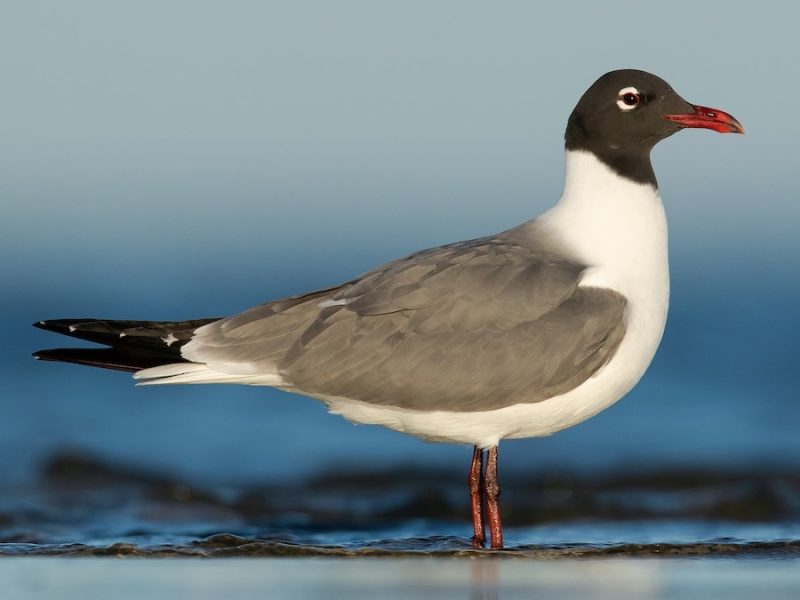
The Laughing Gull is one of the most iconic seabirds found along Florida’s coasts, easily recognized by its striking appearance and raucous vocalizations. During the breeding season, adults sport a bold black head that contrasts sharply with their white underparts and medium-gray wings. Their legs and bill are a noticeable reddish color, with the bill being slightly curved. Outside of the breeding season, their head turns white with scattered gray streaks, making them look more subdued.
This species is medium-sized compared to other gulls, typically measuring around 15 to 17 inches in length with a wingspan of up to 40 inches. In flight, their long, pointed wings and buoyant flight style make them easy to distinguish, especially when gliding effortlessly over beach waves or inland waters. Their call, which sounds like a high-pitched, hysterical laugh, is where they get their name and is a common sound on Florida’s coastlines.
Laughing Gulls are opportunistic feeders with a varied diet. They eat fish, insects, crustaceans, and will readily scavenge human food waste. They are often seen stealing food from other birds or picking scraps in parking lots and piers. Their adaptability to human presence makes them frequent visitors to beach picnics and outdoor dining areas near the coast.
These gulls are found year-round throughout Florida, particularly along the Atlantic and Gulf coasts. They thrive in salt marshes, beaches, islands, estuaries, and even urban environments. Breeding colonies are often located on remote sandy or vegetated islands, while nonbreeding individuals can be seen inland around lakes, rivers, and reservoirs. Their broad range and bold behavior make them the most abundant gull in the state.
Ring-billed Gull (Larus delawarensis)

The Ring-billed Gull is a sleek, medium-sized gull that’s easily identified by the prominent black ring encircling its bright yellow bill. Adults have pale gray backs, white heads and underparts, and bright yellow legs. In nonbreeding plumage, faint brown streaks may appear on their heads, giving them a slightly mottled appearance. Immature birds are browner and more mottled, lacking the ringed bill until they mature.
Measuring around 17 to 21 inches long with a wingspan of about 48 inches, Ring-billed Gulls are graceful in flight and are often seen soaring in flocks above parking lots or water bodies. Their flight is buoyant and smooth, and they often glide with their wings held flat. Their calls are sharp and squeaky, more restrained than the loud laugh of the Laughing Gull.
Ring-billed Gulls are scavengers and foragers with a flexible diet. They consume fish, insects, earthworms, garbage, and even grain from agricultural fields. In urban areas, they are commonly seen at landfills, fast-food parking lots, and boat docks looking for scraps. They’re also known to frequent golf courses and parks with large ponds, where they find both food and rest.
In Florida, Ring-billed Gulls are mostly present during the winter months, arriving in large numbers from their breeding grounds in Canada and the northern United States. While they are not typically seen nesting in Florida, they are widespread from coastal beaches to inland lakes, rivers, and urban centers. Their adaptability allows them to exploit both natural and human-made habitats during their stay.
Herring Gull (Larus argentatus)

The Herring Gull stands out as one of the largest gulls regularly seen in Florida, particularly during the winter season. Adult birds are heavy-bodied with pale gray backs, white underparts, and a distinctive yellow bill marked with a small red spot near the tip. Their eyes are pale with a yellowish orbital ring, and their legs are pink. During nonbreeding months, they often have light streaking on the head and neck, giving them a slightly scruffy look.
With a length of 22 to 26 inches and a wingspan stretching up to 60 inches, Herring Gulls are noticeably larger than other common Florida gulls. They have powerful builds, deep chests, and broad wings that give them a deliberate and confident flight pattern. Their call is a deep, slow “kah” or “kow,” less raucous than the Laughing Gull’s and often uttered while perched or in flight.
These gulls are versatile feeders, consuming fish, mollusks, crabs, carrion, and garbage. They are known for their intelligent foraging behaviors, such as dropping hard-shelled prey from heights to crack them open or stealing food from other birds. Herring Gulls also frequent fishing docks and piers, where they scavenge discarded fish remains and bait.
Though not as abundant as other species, Herring Gulls are commonly seen along Florida’s coasts in winter. They prefer open shorelines, jetties, beaches, and harbors but will also venture inland to large lakes and landfills. Breeding occurs further north, so most individuals seen in Florida are winter visitors or migrants passing through. Their impressive size and deliberate movements make them easy to identify among gull flocks.
Great Black-backed Gull (Larus marinus)

The Great Black-backed Gull is the largest gull species in the world and commands attention with its bold appearance and sheer size. Adults have a striking black back and wings that contrast sharply with their white head, neck, and underparts. Their legs are a pale pink, and the bill is thick and yellow with a prominent red spot near the tip. Immature birds are heavily mottled brown and take several years to reach full adult plumage, gradually transitioning to the stark black-and-white coloration.
This species measures between 28 and 31 inches in length and boasts a wingspan of up to 65 inches, making it significantly larger than other gulls seen in Florida. Its flight is strong and purposeful, with broad wings that allow it to glide powerfully over open water and along shorelines. The call is a deep, grating “ka-ha-ha,” often heard during disputes over food or territory.
Great Black-backed Gulls are aggressive predators and scavengers. They feed on fish, crabs, shellfish, birds’ eggs, and even smaller birds, including other gulls. Their formidable size allows them to dominate feeding areas, often bullying other seabirds away from food. They are frequently seen raiding refuse at harbors and docks, or following fishing boats to scavenge leftovers.
In Florida, this species is considered a rare but regular winter visitor, mostly along the northern Atlantic coast. It is less common than other gulls and usually appears singly or in small groups, especially around inlets, piers, jetties, and beaches. Because of its distinctive dark back and size, it is easy to identify even among mixed flocks of wintering gulls.
Lesser Black-backed Gull (Larus fuscus)
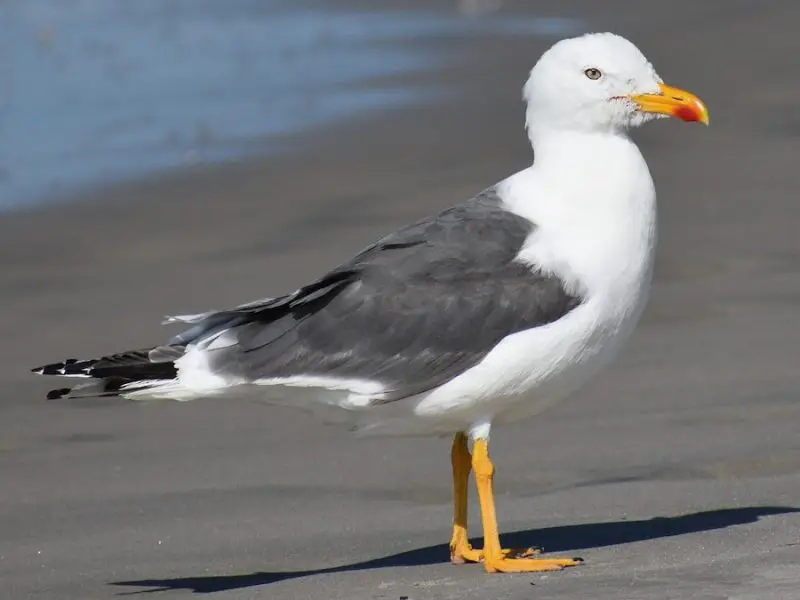
The Lesser Black-backed Gull is a medium-to-large gull with a sleek appearance and more refined build compared to its larger cousin, the Great Black-backed Gull. Adults feature a smooth slate-gray back and wings, white underparts, and bright yellow legs. Their bill is yellow with a red spot, and the eyes are pale with a red orbital ring. Immature birds are mottled brown and take several years to attain adult plumage.
They typically measure around 20 to 24 inches in length with a wingspan of up to 58 inches. Despite their name, their backs are lighter than the Great Black-backed Gull’s jet black, giving them a more subtle look in mixed gull flocks. Their call is a sharp, nasal “kleeew,” less resonant than that of larger gull species, and often given while flying or defending territory.
Lesser Black-backed Gulls are omnivorous and opportunistic, feeding on fish, invertebrates, carrion, and human refuse. They forage both at sea and on land, often spotted combing the shoreline, scavenging in parking lots, or mingling with other gulls at landfills. They also follow boats and patrol piers for discarded food, behaving much like the more familiar Ring-billed or Herring Gulls.
In Florida, the Lesser Black-backed Gull has become an increasingly common winter visitor. Once considered rare, it is now regularly seen along beaches, bays, and urban waterfronts, especially along the Gulf Coast and in the Panhandle. They are most often encountered in mixed-species flocks and are easiest to identify when standing near other gulls due to their distinctive leg color and medium size.
Bonaparte’s Gull (Chroicocephalus philadelphia)

Bonaparte’s Gull is a petite and graceful gull species that brings a delicate touch to Florida’s winter coastlines and inland waterways. In breeding plumage, adults have a distinctive black head, while in winter, the head is mostly white with a small dark spot behind the eye. Their back is pale gray, and the underparts are white. They have slender black bills and orange legs, which further set them apart from larger gull species.
Small in stature, Bonaparte’s Gulls measure about 11 to 13 inches long with a wingspan of approximately 35 inches. Their flight is agile and tern-like, with quick wingbeats and buoyant movement. They often hover or dip close to the water’s surface while foraging, a behavior less common among other gull species. Their calls are high-pitched and soft, giving them a gentler presence both visually and vocally.
They primarily feed on small fish and aquatic insects, often picking prey from the water while in flight. During migration and winter, they may also consume plankton, crustaceans, and occasionally insects from land. They prefer to forage in sheltered coastal waters like estuaries, bays, and river mouths, but are also frequently seen at inland lakes and reservoirs, especially during migration.
In Florida, Bonaparte’s Gulls are winter visitors, most common from late fall through early spring. They are found along both the Atlantic and Gulf coasts, especially in calmer waters where their agile feeding habits are more effective. Although they do not breed in the state, their small size and distinctive flight make them a delightful sight among wintering gull flocks.
Franklin’s Gull (Leucophaeus pipixcan)
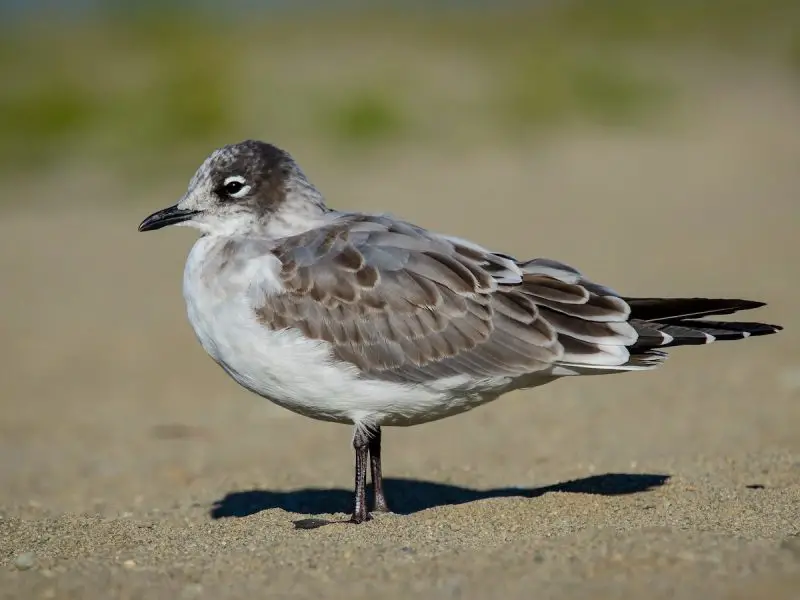
Franklin’s Gull is a small, striking gull most commonly seen in Florida during spring and fall migration. In breeding plumage, adults display a deep black hood, a short red bill, and pinkish legs. Their upper wings are gray with contrasting black tips and distinctive white spots, known as “mirrors,” on the outermost feathers. In nonbreeding plumage, the black hood is replaced by a white head with a dark ear patch, giving them a more subdued look.
At about 13 to 14 inches in length with a wingspan of 35 to 37 inches, Franklin’s Gull is similar in size to Bonaparte’s Gull but is bulkier and more robust. Their flight is buoyant and swift, with strong wingbeats that make them look confident in the air. Their calls are sharp and nasal, and they often vocalize in flight or during foraging.
This species has a varied diet and feeds primarily on insects, especially during breeding and migration. It is commonly seen hawking flying insects over open fields or picking invertebrates from wetland habitats. They also consume small fish and crustaceans in coastal areas. Unlike many gulls, they rely heavily on terrestrial and freshwater sources of food during migration.
Though rare in Florida, Franklin’s Gulls can occasionally be seen in mixed flocks along the Gulf Coast and interior wetlands, particularly during April-May and again in September-November. Their main breeding range lies in the prairies of central Canada and the northern U.S., and they winter along the Pacific coast of South America. Spotting one in Florida is a treat for birders, especially given their unique appearance and elegant flight.
Best Time and Places to See Seagulls in Florida
Florida is one of the best states in the U.S. to observe a wide variety of seagulls, especially during the cooler months. The best time to see the greatest number and diversity of seagulls in Florida is from November to March, when wintering species arrive from the north. During this season, you can expect to see both common and rare species, including Laughing Seagulls, Ring-billed Seagulls, Herring Seagulls, and Lesser Black-backed Seagulls. While Laughing Seagulls are found year-round, many others peak in abundance during the winter migration.
The most reliable places to see large flocks of seagulls are coastal beaches, piers, fishing docks, and estuaries. On the Atlantic Coast, excellent spots include Fort De Soto Park, Canaveral National Seashore, Daytona Beach, and Jacksonville Beach Pier. These areas regularly attract thousands of seagulls that rest, feed, and interact with people. On the Gulf Coast, top locations include Clearwater Beach, St. Pete Beach, Sanibel Island, and Naples Pier, where seagulls often gather around fishermen and beachgoers looking for easy meals.
If you’re birdwatching inland, large bodies of water such as Lake Okeechobee, Lake Apopka, and various reservoirs and landfills around Orlando and Tallahassee can also draw seagulls, particularly Ring-billed and Laughing Seagulls. These inland sites are especially productive during the morning or late afternoon, when birds are most active and feeding.
To get the best seagull-watching experience, try visiting beaches or harbors during low tide, when food like fish and crustaceans are more accessible. Bring binoculars to observe differences in plumage, bill color, and leg color among species. Patience and careful scanning are key, especially when looking for less common visitors like Bonaparte’s or Franklin’s Seagulls that may mix quietly into larger flocks.


